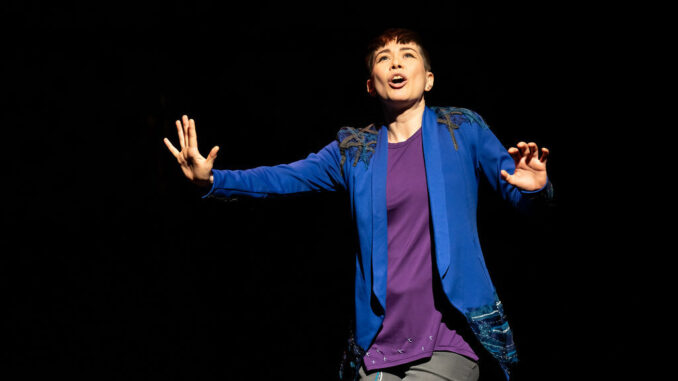
Portland Center Stage (PCS) presented playwright Madeline Sayet’s “Where We Belong” on March 5. The performance has made a profound impact on me, with questions about home, community, identity and expression in the past and present under colonialism still stuck in my head.
The one-woman show was directed by Mei Ann and starred Jessica Ranville, both members of the highly regarded Woolly Mammoth Theatre Company. The 80-minute run time went quickly in the intimate theater setting, which drew focus to the main character Achokayis, given a Mohegan name meaning “…blackbird or the dark one who flies apart.” Ironically, she feared flying.
“Today’s story is how I became a bird,” Acokayis told the audience and explained that the tribe name Mohegan means people of the wolf.
“What does it mean to be a wolf named bird in a place far from home?” she asked.
I anxiously awaited her transformation, hoping every time she looked up at the sky that it would happen, but Achokayis made the audience work for it alongside her.
Achokayis spent a good portion of the story in England pursuing her Ph.D. on “the relationship between the Indigenous peoples of America and Shakespeare’s plays.” She struggled with leaving the Mohegan land and community behind and recited Shakespeare’s words, resorting to Romeo’s monologues, to narrate her internal struggles of upholding her family’s legacy and pondering how she can center Indigenous stories through theater, a field that previously never made the space to respect and honor them.
This focus brought many questions to the surface. Where do Indigenous peoples belong in a world that never imagined them in it? Where does she belong?
The minimalist set design worked to create an environment rich with symbolism. The whole stage was reflective, so whenever the spotlight shined on Achokayis it filled the room with light. Warm, orange, incandescent bulbs and harsh, blue, fluorescent strip lights hung in constellations from the ceiling and occasionally dropped down like stars, just out of reach of the wingless heroine. At points, they represented the outline of a room or a country’s border.
The stage floor had swirled lines of soil laid out across it that Achokayis carefully navigated when the story switched locations, or when she had a change of heart. The soil lit up beneath her feet during her final transformation, leaving me wondering if she had ever really needed wings at all to connect to the sacredness around her.
Achokayis told the story of her Mohegan ancestors who had a dream of helping their tribe and cultivating community and resilience. The ancestor she saw herself the most in was Mahomet Weyonomon, a young man who traveled to England in 1735 demanding to speak to the Crown against the treatment of the tribe. He never got to speak to anyone and was buried in an unmarked grave along the Thames after getting smallpox. His grave could be seen in the soil onstage, with Achokayis finding comfort as she knelt down at his resting place.
“I am grateful for my friend,” Acokayis said. “I return with tobacco and sit with the only other Mohegan in London, this rock.”
A recorded voice repeatedly affirmed, “We must all stand in love for the tribe.” throughout the show. Grounding and reminding both the audience and Achokayis of who she is and how she got there, whether she wanted to hear it or not.
As Achokayis developed her thesis over the course of the show, she quoted Shakespeare less and less, reflecting on just how anti-colonial his work really was – or was not. She realized that she did not need his words to express herself, instead addressing the audience and her ancestors with her native language. “Wigwomun,” she said, speaking to us and them, meaning welcome.
In the end, she returns to Connecticut, to Mohegan land and as promised, transforms into a bird. Leaving was not what changed her, it was returning.
“As I fly, a current of spirits asks me questions, tells me stories,” Achokayis said. “Riding wind I take them with me each time I fly, the ancestors of the earth I’m made of, the water that carried them, and the spirit wind that carries me”
As she ended the story with a Mohegan Welcoming Song, her voice carried throughout the small theater louder than her soliloquies had before.
“Wigwomun, wigwomun wami skeetôpák, oh hai, oh hai, heyuh heyuh, weyuh hey,” she sang.
I got to my feet for a standing ovation as Achokayis’ singing still rang in my ears. As a non-native audience member, I could not and still cannot relate to experiencing microaggressions or being harmed by the legacy of colonialism. I cannot relate to not having proper representation in theater or losing my culture, heritage and language. I can only hope that I can express how much I was moved by it regardless and that I am writing about the author’s and actor’s work as accurately as I can.
Because of my disconnect, I think it is best to let Sayet describe the play’s essence.
“This play is like the river. The sky. The earth,” Sayet said “It holds the stories that came before but also those of this moment which is ever-changing.”
I encourage everyone to read Sayet’s work and see “Where We Belong.” I cannot answer all of the play’s questions, but I believe that Achokayis belongs in the sky.
Subscribe to the Mossy Log Newsletter
Stay up to date with the goings-on at Lewis & Clark! Get the top stories or your favorite section delivered to your inbox whenever we release a new issue.

Leave a Reply